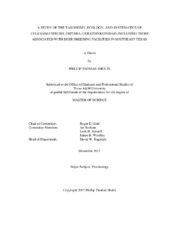| dc.description.abstract | The biting females of a number of species of Culicoides Latreille have a great economic impact throughout the globe. They act as vectors of various disease pathogens, such as Bluetongue, Epizootic Hemorrhagic, African Horse Sickness, various protozoa and nematodes, and in some areas occur in such huge numbers that outdoor activities for humans and domestic animals are severely limited. In spite of their great impact, there are still numerous fundamental aspects of this group that remain unknown. This study fills some of these gaps of knowledge for this genus, including some species of Culicoides in Texas.
In this study, the pupal stage of a vector of the disease-causing agent of Bluetongue in North America, Culicoides sonorensis Wirth and Jones, is described in detail for the first time. A multitude of approaches were used in this description to offer one of the most in depth comparative morphological studies of any ceratopogonid pupa.
This study also interpreted the locality and seasonality data of several Culicoides species by surveying their association with deer breeding facilities in southeastern Texas. A total of twelve species were collected at two sites in the Brazos Valley, with one species being newly recorded in Texas. A synopsis is provided for each species, including seasonality, distribution, feeding habits, and larval habitats.
Molecular study provided 658 base pair CO1 sequences from eight species collected in this study as well as from an additional five species collected in Canada, England, and Ireland; seven of these sequences are new to GenBank. Using a morphological character matrix, a strict consensus tree from 56 equally parsimonious trees was constructed. Analysis of this tree provides evidence for the monophyly of the subgenus C. (Monoculicoides Khalaf) as well as five synapomorphies for the group. Further phylogenetic resolution of some species within the subgenus is also provided. The analysis also indicates that C. rarus Das Gupta has been misplaced in this subgenus. | en |


